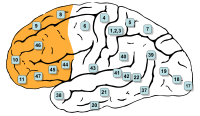
Photo from wikipedia
MicroRNAs (miRNAs) have important contributions to multiple pathophysiological processes for cellular response to stress and are considered as promising therapeutic targets with respect to drug development due to their small… Click to show full abstract
MicroRNAs (miRNAs) have important contributions to multiple pathophysiological processes for cellular response to stress and are considered as promising therapeutic targets with respect to drug development due to their small size, relative ease of delivery, and sequence specificity. Thus, in the current report, we examined the effects of inhibiting miRNA-155 (miR-155) on the levels of pro-inflammatory cytokines (PICs), oxidative stress products as well as vascular endothelial growth factor (VEGF) in the parietal cortex and hippocampus of rats following intracerebral haemorrhage (ICH). Real time PCR was used to examine the levels of miR-155 in the parietal cortex and hippocampus of rats; and ELISA to measure IL-1β, IL-6 and TNF-α, oxidative 8-iso PGF2α and 8-OHdG, and VEGF. Additionally, modified neurological Severity Score (mNSS) was examined to indicate neurological function in animals. In results, with induction of ICH, the levels of miR-155 were amplified in the parietal cortex and hippocampus and this was accompanied with increases of IL-1β, IL-6 and TNF-α; and 8-iso PGF2α and 8-OHdG. Intracerebroventricular infusion of miR-155 inhibitor attenuated the elevation of PICs and amplification of oxidative stress products. Interestingly, miR-155 inhibitor promoted VEGF levels. Furthermore, inhibition of miR-155 led to improvement of neurological deficits in ICH rats. In conclusion, miR-155 signal in the parietal cortex and hippocampus is engaged in the processes of neural injury during ICH and blocking central miR-155 pathway plays a beneficial role in regulating neurological function via reduction in PICs and products of oxidative stress; and enhancement of VEGF. This has implications to target miR-155 and its downstream signal pathway for neuronal dysfunction and vulnerability related to ICH.
Journal Title: Archives of physiology and biochemistry
Year Published: 2020
Link to full text (if available)
Share on Social Media: Sign Up to like & get
recommendations!